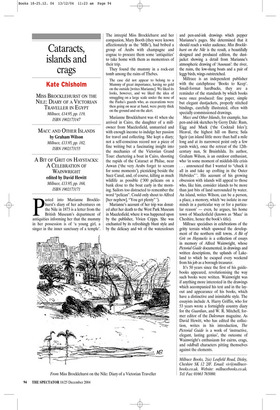Cataracts, islands and crags
Kate Chisholm
MISS BROCKLEHURST ON THE NILE: DIARY OF A VICTORIAN TRAVELLER IN EGYPT Millrace, £14.95, pp. 119, ISBN 1902173147 MACC AND OTHER ISLANDS by Graham Wilson Millrace, £13.95, pp. 182, ISBN 1902173155 A BIT OF GRIT ON HAYSTACKS: A CELEBRATION OF WAINWRIGHT edited by David Hewitt Millrace, £13.95, pp. 168, ISBN 1902173171 Pasted into Marianne Brocklehurst’s diary of her adventures on the Nile in 1873 is a letter from the British Museum’s department of antiquities informing her that the mummy in her possession is of ‘a young girl, a singer in the inner sanctuary of a temple’. The intrepid Miss Brocklehurst and her companion, Mary Booth (they were known affectionately as the ‘MBs’), had bribed a group of Arabs with champagne and cognac to procure them some ‘antiquities’ to take home with them as mementoes of their trip.
They found the mummy in a rock-cut tomb among the ruins of Thebes.
The case did not appear to belong to a Mummy of great importance, having no gold on the outside [writes Marianne]. We liked its looks, however, and we liked the idea of smuggling on a large scale under the nose of the Pasha’s guards who, as excavations were then going on near at hand, were pretty thick on the ground and on the alert.
Marianne Brocklehurst was 41 when she arrived in Cairo, the daughter of a millowner from Macclesfield, unmarried and with enough income to indulge her passion for travel and collecting. She kept a diary; not a self-conscious record nor a piece of fine writing but a fascinating insight into the mechanics of the Victorian Grand Tour: chartering a boat in Cairo, shooting the rapids of the Cataract at Philae, near Aswan (‘the very Arabs forget to scream for some moments’), picnicking beside the Suez Canal, and, of course, killing as much wildlife as possible (‘300 pelicans on a bank close to the boat early in the morning. Sailors too distracted to remember the word “pelican”. Could only shout to Alfred [her nephew], “You get plenty” ’).
Marianne’s account of her trip was donated after her death to the West Park Museum in Macclesfield, where it was happened upon by the publisher, Vivien Cripps. She was enchanted by its refreshingly blunt style and by the delicacy and wit of the watercolours and pen-and-ink drawings which pepper Marianne’s pages. She determined that it should reach a wider audience. Miss Brocklehurst on the Nile is the result, a beautifully designed and produced edition, the dustjacket showing a detail from Marianne’s atmospheric drawing of ‘Assouan’: the river, the ruins, the low-slung boats and a pair of leggy birds, wings outstretched.
Millrace is an independent publisher with the catchphrase ‘Books to Keep’. Small-format hardbacks, they are a reminder of the standards by which books were once produced: fine paper, simple but elegant dustjackets, properly stitched bindings, carefully illustrated, often with specially commissioned drawings.
Macc and Other Islands, for example, has pen-and-ink sketches by Gerry Dale: Rum, Eigg and Muck (‘the Cocktail Isles’); Heaval, the highest hill on Barra; Sula Sgeir (an island little more than half a mile long and at its narrowest point only a few yards wide), once the retreat of the 12thcentury nun, St Bruinhilda. Its author, Graham Wilson, is an outdoor enthusiast, who ‘in some moment of middish-life crisis . . . announced that I wanted to “chuck it all in and take up crofting in the Outer Hebrides” ’. His account of his growing obsession with islands will appeal to those who, like him, consider islands to be more than just bits of land surrounded by water. An island, writes Wilson, can be a person, a place, a memory, which ‘we isolate in our minds in a particular way or for a particular reason’ — even, he argues, his home town of Macclesfield (known as ‘Macc’ in Cheshire, hence the book’s title).
Millrace specialises in celebrations of the gritty terrain which spawned the development of the northern mill towns. A Bit of Grit on Haystacks is a collection of essays in memory of Alfred Wainwright, whose Pictorial Guide documented, in drawings and written descriptions, the uplands of Lakeland to which he escaped every weekend from his job as a borough treasurer.
It’s 50 years since the first of his guidebooks appeared, revolutionising the way such books were written. Wainwright was if anything more interested in the drawings which accompanied his text and in the layout and appearance of his books, which have a distinctive and inimitable style. The essayists include A. Harry Griffin, who for 53 years wrote a fortnightly country diary for the Guardian, and W. R. Mitchell, former editor of the Dalesman magazine. As David Hewitt, who has edited the collection, writes in his introduction, The Pictorial Guide is a work of ‘instructive, elegant, lasting genius’, the outcome of Wainwright’s enthusiasm for cairns, crags, and oddball characters pitting themselves against the elements.

















































































 Previous page
Previous page